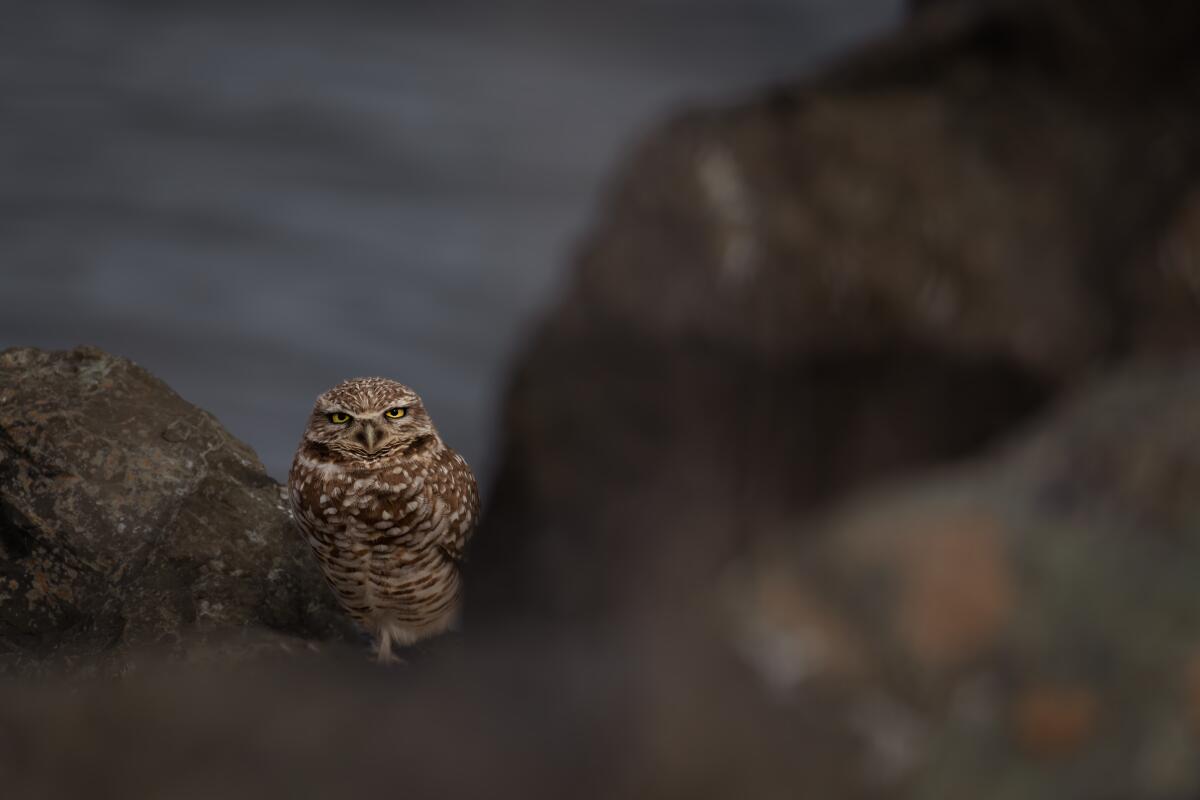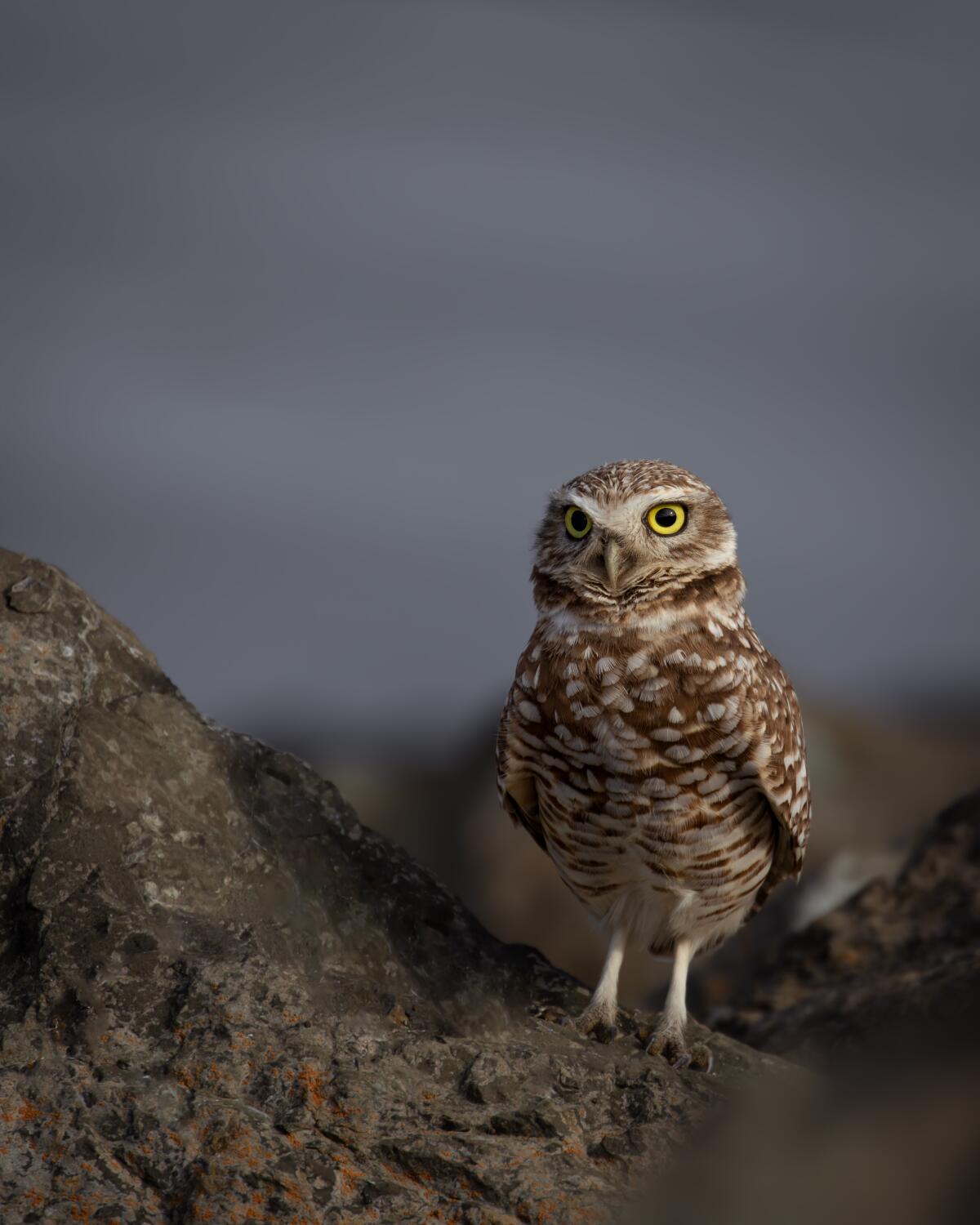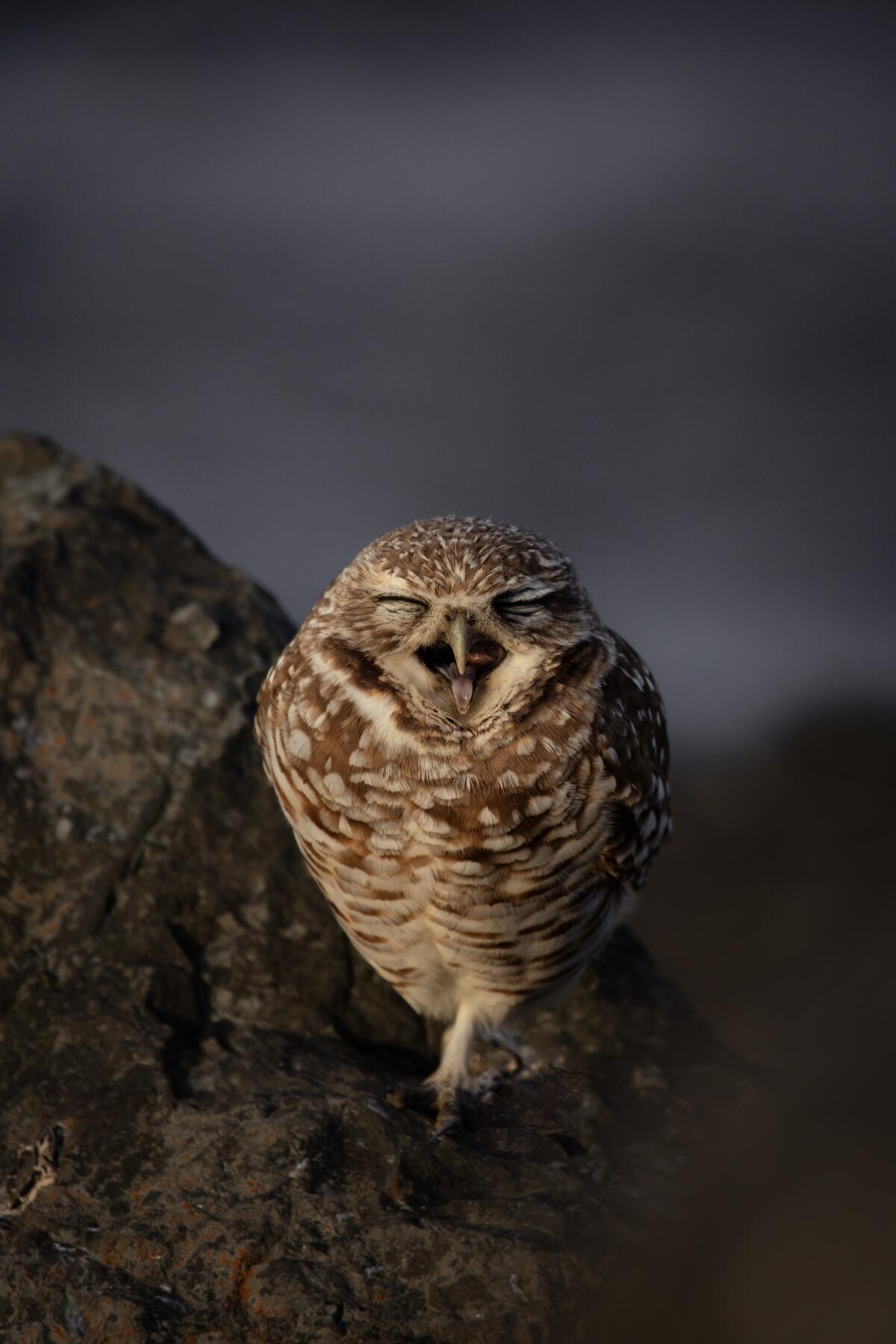Burrowing owl faces ‘death by a thousand cuts,’ advocates say

It’s kind of hard not to be smitten with the burrowing owl.
Standing just 9 inches tall and weighing less than a cup of coffee, these owls prefer to live in the ground, where they feed mainly on insects and small rodents, rather than in trees. Their miniature size, feathery floof and comically big eyes give these birds of prey a charisma that captivates the lens of wildlife photographers and the hearts of even the most clinical environmental scientists.
“Once you see a burrowing owl, you just fall in love,” said Catherine Portman, president of the Burrowing Owl Preservation Society.
But their cuteness hasn’t protected this grassland species from a dangerous decline in population. This month, several wildlife conservation groups petitioned the California Fish and Game Commission to list these owls as endangered or threatened under the California Endangered Species Act.
Their report cites a 2007 statewide survey that measured an 11% decline in burrowing owls since 1993; although no comprehensive population count has be done since, they point to regional studies that show troubling numbers. Researchers Robert L. Wilkerson and Rodney B. Siegel counted 6,408 burrowing owl pairs in the Imperial Valley from 2006-07, but according to another study done by Jeffrey Manning, more than 1 in 4 breeding pairs had disappeared.
Shani Kleinhaus, a resident of Santa Clara Valley and environmental advocate with the local Audubon Society, remembers a time when it was easy to spot these raptors bobbing their heads all across the Bay Area, even in their camouflaged plumage.
“In 2009 we still had burrowing owls in the county that were very accessible to the public so people could see them,” Kleinhaus shared. But now, she said, most if not all of these birds rely on local conservation efforts to help protect their dwindling habitat in the Bay Area and help them pair when they reach reproductive maturity.
Why are the owls disappearing?
According to the most recent census, 70% of burrowing owls in the state of California reside in the Imperial Valley and surrounding areas in Southern California. As housing developments push farther and farther out from the state’s urban cores and wind and solar farms expand in rural areas, these owls have found themselves sometimes competing with humans for real estate.
But it’s a little more complicated than rapacious developers versus hapless birds; there’s plenty of blame to spread around.
Burrowing owls rely on ground squirrels to help build their nests, but farmers often kill them as pests because they nibble on electrical wiring and feed on produce. Feral cats and roving hounds have been known to hunt them down. Invasive grasses brought by Spaniards during the late 1700s to feed their livestock have made grasslands less habitable for ground squirrels and burrowing owls alike.
There are mitigation fees that developers pay if they are encroaching on burrowing owl habitats. And the Migratory Bird Treaty Act and the California Fish and Game Commission codes afford protections to burrowing owls, but advocates say it’s not enough.

The decline of the owl is ‘death by a thousand cuts’
These environmentalists have petitioned to protect the burrowing owl before, most recently in 2003 when scientists like Lynne Trulio noticed a worrisome decline in the population of burrowing owls across the state. That petition was rejected because the state noted that the owls were flourishing in the Imperial Valley with the increase in agriculture in the 1990s.
“[Burrowing owls] should have been listed back then, in my opinion,” said Trulio, chair of the environmental studies department at San Jose State University. “What’s different 20 years on is that the trend that we saw in 2003 decline has steepened, and has gotten worse.”
Esther Burkett, senior environmental scientist at California Department of Fish and Wildlife, admits there aren’t enough legal protections for the owls and that the state bureaucracy can make it difficult to act quickly. (Her department is not to be confused with the Fish and Game Commission; her team does the research that informs the policy and rules that the Fish and Game Commission decides.)
“You got to know what you’re looking for. So, ideally, for any species, the actual surveyor needs to be trained on how to do that,” said Burkett. “[If] you miss a review of that [California Environmental Quality Act] document you don’t get another chance at it. And then we’re gonna lose three [breeding] pairs and it’s just death by a thousand cuts over time.”
Burkett manages a wide array of species in the state and said she’s overwhelmed by the need and the lack of resources she has to address the problems facing many of these animals. The last time they put together a comprehensive report on burrowing owls was in 2012, and even that report took four years to put together. She likens the situation to a hospital where they’re trying to address many patients — species tagged as “special interest” like the burrowing owl are in the ICU, but most of their resources are going toward endangered and threatened species in the emergency room.
Activists intervene on the owls’ behalf
Portman spends a lot of her time teaching Californians how to apply the California Environmental Quality Act to protect burrowing owls. The statute, which Gov. Ronald Reagan signed into law in 1970, requires developers to gauge the environmental effects of their projects and plan how to mitigate them — and allows the public to challenge them. But it’s not always easy to make sure these agencies are doing their due diligence.
“I don’t put that on the developer. I put that on the land use jurisdictions,” said Portman. The agency tasked with preparing the environmental impact report usually makes the developer bankroll it, and it’s in the developer’s interests to hurry the project toward completion. “The city councils, the county Board of Supervisors, whoever the lead agency is, gets to decide how that land is used,” Portman said, but they “do not take full advantage of the authority that they had.”
Other scientists are working to increase the chances burrowing owls can survive and successfully reproduce. For example, the San Diego Zoo Wildlife Alliance, which has been collaborating with agencies and municipalities to save the burrowing owl, recently released some owls that had been rescued from near-certain death as chicks.
Jeff Miller, senior conservation advocate at the Center for Biological Diversity, was author of both petitions; he’s one of the few activists who remembers when biologists started sounding the alarm in the 1990s. Miller believes the outcome of this petition could be different because the priorities of the commission have shifted over time.
Back when the Fish and Game Commission began, Miller said, “everything was managed as to be fished or to be hunted.” Today, more board members have expertise in environmental issues, he said, and “there’s a lot more emphasis on conserving imperiled species.” The commissioners did not respond to The Times’ request for comment.

Burrowing owls and California’s grasslands
Burrowing owl advocates said the goal of listing the bird as an endangered species is to eventually get it off the list. But Trulio thinks listing the bird under California’s Endangered Species Act could be the key to preserving the state’s grasslands.
Trulio’s speciality is urban species, and she’s contributed to the research that underpins Santa Clara County’s habitat conservation plan on burrowing owls. But before that she was also the lead scientist for the South Bay Salt Pond Restoration Project, one of the largest tidal wetland restoration projects on the West Coast.
“One of the things that drove the effort was the fact that there were endangered species” in wetlands, said Trulio. She said it took years to change the perception of the wetlands as a dumping ground and to get a ballot measure to fund its preservation.
Where developers might look at grasslands as vast empty landscapes to build on, Trulio said, she sees their value to the public as spaces for outdoor recreation and sequestering carbon to fight climate change. It’s not just about protecting this one species of bird, but the ecosystem they inhabit, Trulio said.
“We need to protect burrowing owls before urbanization takes hold,” Trulio stated. “Once urbanization takes hold, what really happens is land values become so high that you can’t protect them.”
The double-edge nature of visibility
Lauren Bettino, a Bay Area wildlife photographer, had never seen a burrowing owl before she set out to Point Isabel Regional Shoreline to snap a photo of these rare birds.
Bettino was taking a break from her search and sat down on a rock only to realize she happened to share a perch with a burrowing owl. “He was not concerned about me at all,” Bettino recalled. “I spent probably an hour and a half to two hours just sitting next to him and watching him.”
Bettino tries not to advertise exact locations of where she photographs wildlife because it could attract over-zealous photographers who could disturb them. But she’s believes sharing pictures of the burrowing owls is an important way to encourage people to care more about their natural neighbors; she knows most people are not field biologists.
The Audubon Society’s Instagram page often features burrowing owls where they are liked by thousands of viewers. To Kleinhaus it makes sense why there’s such an outpouring of love. “Seeing an owl opens your eyes to something very mythical or primordial,” she said. “It elicits emotion not just from me, but anyone who sees them.”







